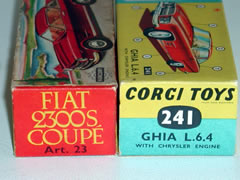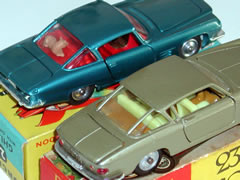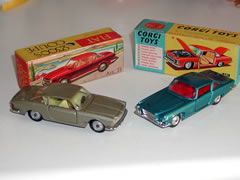|
The Mercury Turin-based company began
producing toys immediately after the war, resulting fairly successful
in the field of small-scale car models. During the decade from
1953 to 1962 the production of 1/48 scale models (just a bit
smaller than the Corgi, Dinky etc.) was a huge success and those
models are now highly sought after by collectors around the
world.
In the early sixties the most important companies began to enter
into a serious and fair competition and began churning out models
with many openings, fitted with windows, interior trim and suspensions,
metallic paint, rhinestones in headlights and reclining seats.
Some had their steering front wheels, others boasted fantastic
gadgets, such as headlights which light up (eg. the well-known
"Trans-o-lite" of Corgi Toys) or working wipers (Mercedes
Benz 600 Pullman, of Corgy Toys, which had also sliding windows).
At that point there was the need to keep
up the production with that of “the fierce competition”, therefore,
in 1962, also Mercury made a great leap forward in quality,
by adopting the more common 1/43 scale and producing the wonderful
Fiat 2300 S coupé Ghia, which even without the little
puppy crouched under the rear window could easily keep up with
another beautiful reproduction of a Ghia car: the Chrysler 6.4L
V8 of Corgy Toys (art. 241, 1963). The comparison between the
two models is shown on the right.
Once the situation improved, Mercury
produced, in my opinion, a series of beautiful models, among
which I would especially like to remind the Lancia Flavia Coupé
Pininfarina, the Maserati 3500 GT, the Mercedes Benz 230 SL
"Pagodina".
Then, it was the turn of the Fiat Models,
among them stands out the "family" of 850, produced
in different variants: sedan, coupé, spider, Abarth etc.
In the big picture above, the family of the 850 shines in many
different colors, more or less rare to find. It is such a great
joy to see them all together, so much that you almost feel the
urge to lie down among them like Scrooge McDuck with his heaps
of dollars hoarded in his crowded store.
It is true, the Mercury did not skimp
out on the colors and this makes the hunting of its models even
more fascinating. I am referring, for instance, to some Corgi
models that have been produced in only one or two colors: the
Chevrolet Corvair (usually blue), the aforementioned Mercedes
600 (always in metallic red), the R 16 (always in metallic dark
red), the Oldsmobile Super 88 (almost always in light blue and
white) and so on .... how boring. Mercury, however, changed
the paint color very often: just think of the countless variations
of the 600 Multipla (pictured below) or the Flavia Coupé
(see large photo below). Sometimes eBay shows color variations
never seen before and the relentless desire to have it in the
garage sets off.

Of course, Mercury as well, like all
other brands, has sought to reduce costs by using models already
known to produce special versions: just think of the Pagodina,
which after the open and closed versions created the original
Safari version. Or the series of the Ferrari 330 P, produced
in different versions: Silverstone, Monza, Nurburgring Sebring
and so on. Or, again, the Maserati 3500’s competition version,
which, unlike the others just mentioned, was not considered
worthy of a box of its own, and was sold in the box of the GT
road version, with the word "COMPETITION" overwritten
with an ink-pad on the closing flap. The laws of the market
are always tough.
The same Fiat 2300 S Coupé Ghia
has led to a rethinking of the manufacturer two years after
its debut: a simplified version was produced, with the silver
painted headlights (rather than applied) and with other simplifications.
The first set was too expensive, but the simplified version
today is sold at a price which is higher than that of the original
series: a small revenge.
After 1969, however, all the companies
showed signs of crisis and many have closed down or have started
producing cheaper series. Politoys produced the Export series
(horrible in comparison to the M series), Mebetoys produced
the Europe series (same bad review), Solido produced the series
10 (unacceptable if compared with the series 100), Corgi produced
the Whizzwheels series (which, to be fair, were beautiful models,
if you pretend not to notice those fast but squalid small wheels).
And the Mercury? It produced the series
300, namely the "Special", which also includes some
very interesting models, but of lower quality than those manufactured
from 1962 to 1969.
For this reason, I wish to devote this website to remember the
only models produced during those years. There will be other
opportunities in future to extend the classification to the
later models.
|

TWO GHIA MODELS
COMPARED
MERCURY
#23/1962
FIAT 2300 S COUPE' GHIA
V
CORGI TOYS #241/1963
GHIA 6.4L CHRYSLER V8 ENGINE
Engines are very different,
2300cc for FIAT and as much as 6400cc for Chrysler, but the
two cars do not hide to be related as for their style: the
rear window divided into three parts shows their similarity
as a common DNA.

The two models are both beautiful:
fully opened, equipped with suspensions, interior, metallic
painting and etc.. The Corgi one is more solid and better
finished, with the usual riveted base that prevents the disassembly
and with a thicker high quality painting. However, the Mercury
is every bit as good as the Corgi: the paint is more fragile,
but the bumpers are chrome metal, very sturdy (the Corgi ones
are made of plastic and the chrome plating tends to peel off).

The seats have reclining
backs, but the Corgi ones boast the most exquisite workmanship
(the FIAT back seats move just a little due to the elasticity
of the plastic, while others are more pliable). Both have
also the lining on doors and dashboard, decorated with decal
(2300) or with a coated adhesive paper (6.4L).


Only the Mercury though has
the TO (Turin) plate and the headlights set in transparent
plastic. The trunk has a plastic coating on the bottom. The
Corgi model has an easy opening in the engine hood: you just
need to push the front suspension and a piston comes out of
the air filter and lifts the lid a few millimeters, just enough
for you to easily lift it. It has jewel headlights and under
the rear window there is the puppy who waits for his owner.
It’s a bad habit that of leaving the dog locked in the car,
and the puppy takes his revenge: it is responsible for the
spinning on the rear window, very common defect in this model.
When you inadvertently press the rear window, pressure is
distributed unevenly and this breaks the plastic right where
the pretty puppy is crouched.

|